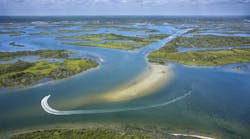Storm Water Earns 'D' on ASCE 2021 Infrastructure Report Card
About the author:
Katie Johns is managing editor of SWS. Johns can be reached at [email protected].
On March 3, the American Society of Civil Engineers announced its 2021 Report Card for America’s Infrastructure.
The report card graded 17 categories, including drinking water, wastewater, roads and, for the first time, storm water. For its inaugural appearance on the Infrastructure Report Card, storm water has received a D.
According to the report card website and storm water report, “with few dedicated funding sources, complicated governance and ownership structures, expansive networks of aging assets, increasingly stringent water quality regulations, and concerning climate change projections, the expected performance of storm water systems is declining.”
The report nodded to the Water Environment Foundation’s 2020 National MS4 Needs Assessment Survey, the results of which were released in February. The survey found that the sector’s annual funding gap is estimated to be $8.5 billion. That number is a 10% increase over the funding gap found in WEF’s 2018 survey.
Currently, storm water utilities are on the rise – more than 40 states have at least one.
"Out of communities with municipal MS4s, the percentage with stormwater utilities or fees has grown from approximately 19% in 2013 to upward of 26% in 2018," the report said.
And while this number is increasing, the report found that impervious surfaces in cities and suburbs are also expanding, which exacerbates urban flooding. This results in $9 billion in damages annually. The report also stated that nearly 600,000 miles of streams and rivers are considered impaired.
When looking at storm water, wastewater and drinking water together (wastewater received a D+ and drinking water received a C-), the report stated: “separately, an economic analysis by ASCE shows a water-related infrastructure investment gap of $434 billion over 10 years for drinking water, wastewater, and stormwater combined.”
Overall, the U.S. received a grade of C-. This is the first time in 20 years the country has received a grade in that range. According to an ASCE press release, this means “on average, the nation’s infrastructure is in mediocre condition, has deficiencies and needs attention.”
Eleven out of the 17 categories earned a score in the D range, including roads, schools, transit, aviation, dams, hazardous waste, public parks, inland waterways, levees and storm water and wastewater. Transit, at a D-, earned the lowest grade. Grades improved for aviation, drinking water, energy, inland waterways and ports.
ASCE has found that the long-term infrastructure investment gap continues to increase. According to the press release, “that gap has risen from $2.1 trillion over 10 years in the last report to $2.59 trillion in the latest study, meaning a funding gap of $259 billion per year.”
There were 22 weather and climate disasters that cost the U.S. $1 billion in 2020, the most in history, according to the press release.
“America's infrastructure bill is overdue, and we have been ignoring it for years. The COVID-19 pandemic only exacerbates the funding challenge because state and local governments have had to prioritize public health over everything else for the past year,” said Jean-Louis Briaud, P.E., ASCE president in the press release. “If we take action now, we can generate job growth and build infrastructure that is more reliable, more secure and more resilient while increasing the quality of life for everyone.”
About the Author
Katie Johns
Katie Johns, editor-in-chief of Stormwater Solutions, graduated from the University of Missouri in 2016 with a Bachelor of Journalism and a Bachelor of Arts in Spanish. Johns joined the Stormwater Solutions team in September 2019. Johns also helps plan the annual StormCon conference and co-hosts the Talking Under Water podcast. Prior to entering the B2B industry, she worked as a newspaper reporter and editor in Sarasota, Florida, and a magazine assistant editor in the Chicago suburbs. She can be reached at [email protected].



